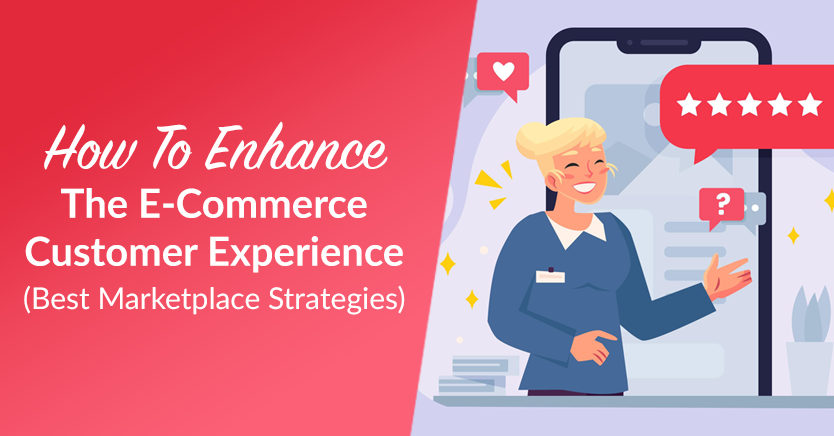
When it comes to the multi-vendor marketplace industry, competition is fierce and attention spans are fleeting. Thus, if you want to stand out, you must take advantage of every strategy in your arsenal – including delivering exceptional e-commerce customer experience.
Today, we’ll discuss the compelling reasons why your marketplace should prioritize and invest in enhancing e-commerce customer experience. In addition, we’ll give you some valuable tips on how to improve it for the benefit of your business.
So let’s get cracking!
What Is E-Commerce Customer Experience?
Customer experience refers to every way customers interact with your company from the start to the end of the customer journey. This includes talking to customer service, seeing ads, or even just paying a bill. Each of these interactions shapes how customers view your business.
Therefore, e-commerce customer experience refers to all the interactions customers have with an online store or platform at every stage of their shopping journey. This includes browsing products, making purchases, contacting customer support, receiving items, and any other interactions they may have with the online marketplace. The goal is to make these interactions seamless, convenient, and enjoyable for the customer, ultimately leading to increased satisfaction, loyalty, and repeat business.

5 Reasons Why E-Commerce Customer Experience Is Crucial To Your Marketplace
So, why should you spend time and effort improving customer experience? Check out its benefits below!
1. Builds trust and loyalty
In the digital realm, where clicks and scrolls replace face-to-face interactions, trust becomes the cornerstone of successful transactions. By offering seamless, personalized experiences, you instill confidence in your customers, fostering long-term relationships and repeat business.
In fact, one study states that 60% of shoppers buy from a brand solely because of the service they expect to get.
Furthermore, keep in mind that a satisfied customer is not just a one-time sale. They’re also a brand advocate who amplifies your marketplace’s reputation through word-of-mouth recommendations.
2. Differentiates your marketplace
With so many options available at the click of a button, setting your marketplace apart in the crowded e-commerce landscape is no easy feat. Thankfully, investing in e-commerce customer experience allows your platform to carve out a distinct identity amidst the noise.
Whether it’s through intuitive navigation, responsive customer support, or tailored recommendations, providing an exceptional customer experience allows you to stand out among competitors and position your platform as the go-to shopping destination.
According to one study, 73 percent of shoppers will start purchasing from a competitor if they have several bad experiences with a business.
3. Increases conversion rates
The journey from browsing to purchasing is laden with potential roadblocks that can derail even the most enthusiastic shopper. By optimizing every touchpoint of the customer journey, from initial discovery to post-purchase support, you streamline the path to conversion, reducing friction and boosting sales.
Thankfully, a seamless, frictionless e-commerce customer experience encourages first-time buyers to complete their transactions. Case in point: one study learned that 73% of customers prioritize customer service as the most important factor when deciding whether to buy from a company.
As if that weren’t good enough, exceptional customer service also cultivates a sense of confidence that keeps shoppers coming back for more.
4. Drives revenue growth
Contrary to popular belief, investing in e-commerce customer experience is not just a cost center – it’s a revenue generator.
Studies have consistently shown that businesses that prioritize customer experience do much better than their competitors when it comes to profitability and revenue growth. One study discovered that companies that prioritize customer experience an 80 percent rise in revenue.
By delighting customers at every interaction, you not only increase the lifetime value of each customer but also unlock new avenues for upselling and cross-selling, driving incremental revenue and sustainable growth.
5. Future-proofs your business
Adaptability is key to survival in the rapidly evolving landscape of e-commerce. Thankfully, by making e-commerce customer experiences a core focus of your marketplace strategy, you future-proof your business against shifting consumer preferences and technological advancements.
Whether it’s embracing emerging technologies like AI and machine learning to personalize recommendations or leveraging data analytics to gain actionable insights, it’s a great idea to invest in your marketplace customer experience to thrive in an ever-changing market.

How To Improve E-Commerce Customer Experience
Now, it’s time to learn how to enhance the e-commerce customer experience so you can enjoy all the previously discussed benefits!
1. Personalize the customer experience
Creating a personalized experience for customers is extremely important for making them feel special. This means giving them suggestions for products they might like, sending personalized emails, and reaching out to them in the way they prefer.
To do this well, it’s essential to learn about your customers – what they like, how they behave, and what they prefer. Then, use this info to help your customer service team personalize their support and solve problems faster. Doing some research on how your support efforts are going can also help you figure out ways to make interactions with customers even more personal.
Example
Let’s say you run an online bookstore. You could personalize the customer experience by:
- Offering tailored book recommendations based on their past purchases or browsing history.
- Sending birthday emails with special discounts on genres or authors they’ve shown interest in.
- Providing customer service through chat, email, or phone based on their preferred communication method, which they might have specified in their account settings.
These simple gestures show customers that you value their individual preferences. As a result, they enhance the e-commerce customer experience and make shopping on your online bookstore more enjoyable and rewarding.
2. Offer proactive experiences
An excellent e-commerce customer experience predicts what customers might need and addresses issues before they become significant problems. Being proactive creates a special feeling for customers and helps to build trust and loyalty.
There are many ways to be proactive. For instance, you could send a regular shopper an email recommending products based on their browsing history or past purchases. You could send customers a text message to inform them that your marketplace is holding a sale. Or you could use a chatbot on the checkout page to answer any last-minute questions customers might have.
By anticipating and addressing potential customer concerns in advance, you create a more satisfying e-commerce customer experience.
Example
Suppose you run a subscription-based meal delivery service. You could be proactive by sending customers a reminder a day before their scheduled delivery, along with a quick survey asking if they have any dietary restrictions or preferences they’d like to update. This way, you anticipate their needs, show that you care about their preferences, and prevent any potential issues or surprises with their delivery.

3. Grant self-help solutions
Not all customers want to deal with store owners directly, so it’s vital to provide them with ways they can help themselves.
Thus, it’s a good idea to write articles and craft FAQ pages that empower customers to resolve their own issues without the need to contact support. Just remember to update your content whenever necessary, as inaccurate information can lead to confusion and frustration with your brand.
In addition, you should consider those who like getting their information from other buyers, so creating community forums is a must.
Another excellent solution is to use AI chatbots. These can offer instant assistance and guide customers effectively.
Example
Imagine you manage a software marketplace. You could offer a self-service portal where customers can find troubleshooting guides and tutorials for common issues. In addition, you could implement an AI-powered chatbot on your online marketplace to offer swift aid with frequently asked questions. This way, you can reduce the need for customers to wait for live support.
Such strategies save time for both customers and support agents. Furthermore, they enhance the overall e-commerce customer experience.
4. Establish feedback systems
A great strategy is to seek feedback from customers, which involves gathering their input about their experiences with your marketplace. This helps you gain crucial insights into their expectations, thus allowing you to identify areas of success and areas that need improvement. Ultimately, this lets you enhance your platform, products, and processes.
Furthermore, taking action based on feedback demonstrates respect for customer opinions. Thus, feedback systems can also do wonders for your marketplace’s image!
Additionally, you can implement internal feedback mechanisms among your vendors to address challenges regarding how to deliver excellent e-commerce customer service. This might involve identifying policies or procedures that don’t align with customer needs or tackling communication barriers between vendors and the marketplace.
Example
Let’s say you own a food marketplace. You could implement a feedback system where customers can leave comments or suggestions on their dining experience through a digital survey. Based on this feedback, you might discover that customers desire more vegetarian options on your platform. You then make an effort to look for vendors specializing in vegan food to meet these customers’ demands. By doing so, you cater to customer preferences, enhance the overall dining experience, and even attract new customers to your marketplace.

5. Implement an omnichannel support system
Customers dislike having to repeat their concerns to different support agents, yet it’s challenging for companies with separate departments to avoid this issue. The solution lies in creating an omnichannel experience that meets shoppers at their chosen location and ensures consistency throughout their journey. Basically, this means allowing customers to interact with you via different channels, including email, social media, phone calls, comment sections, forums, and the like.
To enhance this approach, you can use tools that analyze customer data. This can help you understand customer behavior and preferences across the different channels. Then, based on the information you collect, you can make interactions more personal and better predict what customers might need.
Remember, understanding your customers’ identity, previous interactions, purchase history, and more is vital. After all, this lets you deliver a smooth experience across various channels. Moreover, employing customer service software equipped with omnichannel routing allows you to distribute inquiries across channels to team members based on priority, availability, and workload.
Example
Imagine you manage an online clothing marketplace. You could implement an omnichannel support system that integrates live chat, email, and phone support into a single platform. This way, customers can reach out through their preferred channel. Moreover, your support team can seamlessly handle their inquiries regardless of the communication channel, providing a proactive and unified e-commerce customer experience.
6. Cultivate a community-centric approach
Encouraging a sense of community among your customers can greatly enhance the e-commerce customer experience. By fostering interactions between buyers, you create a space where customers can ask questions, share their experiences, and provide recommendations to each other.
One way you can do this is by establishing social media groups or online forums where customers can connect. Furthermore, you can set up virtual events or webinars that let customers learn more about your products while engaging with fellow shoppers.
Additionally, you can incentivize community participation by offering rewards or discounts to customers who actively contribute to the community. By building a strong sense of belonging and camaraderie, you not only enhance the overall customer experience but also foster loyalty and advocacy among your customer base.
Example
Suppose you own a gardening supplies marketplace. You could create a Facebook group called “Garden Lovers Community” where customers can share tips, ask questions, and show off their gardening projects. You could also host monthly virtual Q&A sessions with gardening experts where customers can join in, ask questions, and learn new gardening techniques.
By fostering this community, you’re not only providing valuable resources to your customers but also creating a space where they can connect and feel part of a supportive community.

7. Employ AI and automation
Thanks to automation and artificial intelligence (AI), e-commerce businesses today have become more effective at serving customers. In fact, the use of AI, more specifically generative AI for marketing, is becoming so common that it would be unusual to find an online store or marketplace that doesn’t take advantage of the technology.
Chatbots driven by AI and other automated kinds of support tools are great at handling fast, repetitive tasks. For example, they can greet customers, inform them about special promotions, and even answer basic questions.
But what if a chatbot can’t solve an issue? Simple: it can smoothly transfer the customer to a human member of your support team. And there’s no worry about having to start the interaction from scratch, as the chatbot will provide your human support with the data it’s collected so far.
For WooCommerce marketplace owners, tools like WooCommerce AI take this a step further by automating personalized product recommendations, optimizing inventory forecasting, and even generating SEO-friendly product descriptions at scale.
By integrating AI directly into your platform, you can create hyper-relevant shopping experiences that adapt to individual customer behaviors, ensuring your marketplace stays competitive in an era where personalization drives loyalty.
Example
Imagine you manage a toy marketplace. You could implement an AI-powered chatbot that greets customers when they visit your site, offers product recommendations, and assists them with any inquiries or concerns they may have. This proactive approach not only provides immediate assistance to customers but also enhances their overall shopping experience by making it more personalized and convenient.
8. Prioritize transparency and honesty
Being honest and transparent with your customers develops credibility and trust, which are imperative for a successful e-commerce business. Thus, always provide clear and accurate product descriptions, including information about materials, dimensions, and any potential limitations or drawbacks.
Additionally, be upfront about pricing, including any additional fees or charges, to avoid surprises at checkout. If there are delays or issues with orders, communicate openly with customers and provide regular updates on the status of their purchases.
By prioritizing transparency and honesty in your interactions with customers, you demonstrate integrity and reliability. This can boost the e-commerce customer experience and encourage long-term customer satisfaction and loyalty.
Example
Picture this: you run a cosmetics online marketplace. When describing a lipstick, be clear about its color, ingredients, and size, so customers know exactly what they’re buying. Also, make sure the price shown includes any taxes or shipping fees, so there are no surprises at checkout.
If there’s a delay in shipping the lipstick, send the buyer an email informing them about the situation and providing them with an approximate delivery date. Keeping them informed builds trust and shows that you’re honest and reliable, in turn enhancing the e-commerce customer experience.

9. Provide seamless and secure payment options
Offering various payment methods and guaranteeing secure transactions is critical for improving the e-commerce customer experience. Thus, provide popular payment options such as credit/debit cards, PayPal, and digital wallets like Apple Pay or Google Pay to accommodate different customer preferences.
Implementing secure payment processing systems with encryption and fraud detection measures protects customers’ sensitive information. Thus, it also gives them peace of mind when making purchases online. Displaying trust badges and SSL certificates on your website further reassures customers about the security of their transactions.
By providing seamless and secure payment options, you remove barriers to purchase and create a smoother shopping experience, increasing customer satisfaction and trust in your online store.
Example
Let’s say you own a fashion marketplace. When customers shop on your platform, they can pay with their debit or credit, PayPal, or even their smartphone using services like Apple Pay.
To make sure their payment information is safe, your website uses special technology to encrypt their data. This means it’s scrambled into code that only you and the payment processor can read. Plus, you show badges on your site that tell customers it’s secure.
So, when customers check out, they feel confident that their payment is secure, making their shopping experience smooth and worry-free.
10. Harness the power of data and analytics
Data and analytics provide a treasure trove of information about consumers, including how well your customer support team performs, how satisfied customers are with their interactions, trends in consumer behavior, and more.
For example, you can analyze data to discover which products are most popular among different age groups. Then, you can customize your marketing strategies to more effectively reach particular demographics. This allows you to adjust your advertising strategies accordingly to attract different groups effectively.
Remember, if you want to improve an aspect of your marketplace, it’s crucial to analyze data and its relevance to your business. After all, this allows you to identify areas of improvement, understand customer needs, and plan for the future.
Example
Let’s say you manage an online electronics marketplace. By examining data on customer browsing and purchase history, you notice that customers tend to abandon their shopping carts before completing a purchase. In response, you implement proactive measures such as sending reminder emails to customers with abandoned carts and offering them special discounts to encourage them to complete their purchases.
This data-driven approach helps improve the overall e-commerce customer experience and increases conversion rates for your store.

Conclusion
Providing superior e-commerce customer experience is a surefire way to make your multi-vendor marketplace a more compelling shopping destination.
To recap, great customer experience benefits your platform in various ways. Specifically, it:
- Builds trust and loyalty
- Differentiates your marketplace
- Increases conversion rates
- Drives revenue growth
- Future-proofs your business
To enhance the e-commerce customer experience, implement the following strategies:
- Personalize the customer experience
- Offer proactive experiences
- Grant self-help solutions
- Establish feedback systems
- Implement an omnichannel support system
- Employ AI and automation
- Cultivate a community-centric approach
- Prioritize transparency and honesty
- Provide seamless and secure payment options
- Harness the power of data and analytics
Do you have any questions about improving your marketplace’s e-commerce customer experience? Let us know in the comments section!
